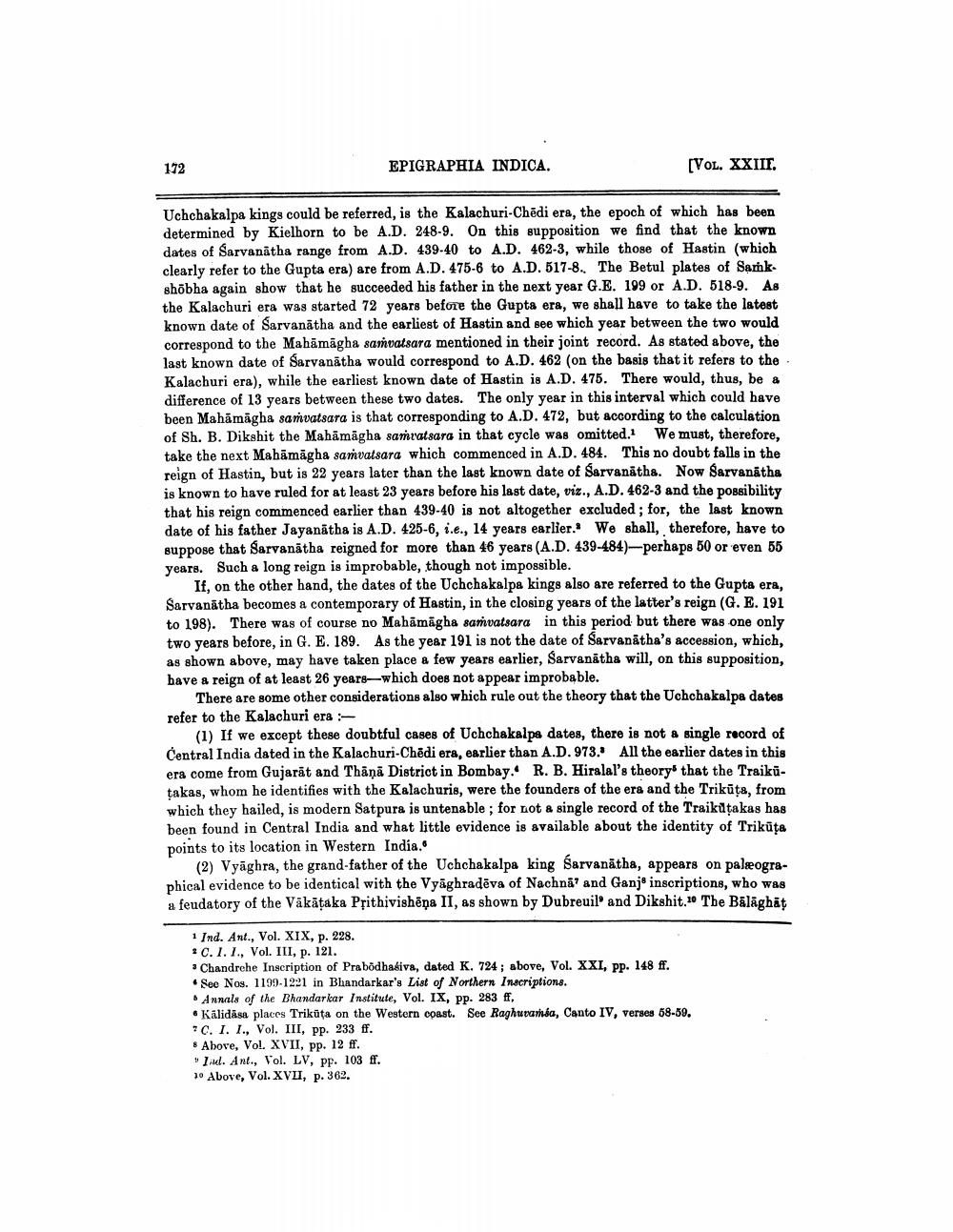________________
172
EPIGRAPHIA INDICA.
[VOL. XXIII.
Uchchakalpa kings could be referred, is the Kalachuri-Chēdi era, the epoch of which has been determined by Kielhorn to be A.D. 248-9. On this supposition we find that the known dates of Sarvanātha range from A.D. 439-40 to A.D. 462-3, while those of Hastin (which clearly refer to the Gupta era) are from A.D. 475-6 to A.D. 517-8. The Betul plates of Samk. shobha again show that he succeeded his father in the next year G.E. 199 or A.D. 518-9. As the Kalachuri era was started 72 years before the Gupta era, we shall have to take the latest known date of Sarvanātha and the earliest of Hastin and see which year between the two would correspond to the Mahāmāgha samvatsara mentioned in their joint record. As stated above, the last known date of Sarvanātha would correspond to A.D. 462 (on the basis that it refers to the Kalachuri era), while the earliest known date of Hastin is A.D. 475. There would, thus, be a difference of 13 years between these two dates. The only year in this interval which could have been Mahāmāgha sarvatsara is that corresponding to A.D. 472, but according to the calculation of Sh. B. Dikshit the Mahāmāgha samratsara in that eycle was omitted. We must, therefore, take the next Mabāmágha samvatsara which commenced in A.D. 484. This no doubt falls in the reign of Hastin, but is 22 years later than the last known date of Sarvanäths. Now Sarvanätha is known to have ruled for at least 23 years before his last date, viz., A.D. 462-3 and the possibility that his reign commenced earlier than 439-40 is not altogether excluded; for, the last known date of his father Jayanātha is A.D. 425-6, i.e., 14 years earlier. We shall, therefore, have to suppose that Sarvanātha reigned for more than 46 years (A.D. 439-484)---perhaps 50 or even 55 years. Such a long reign is improbable, though not impossible.
If, on the other hand, the dates of the Uchchakalpa kings also are referred to the Gupta era, Sarvanātha becomes a contemporary of Hastin, in the closing years of the latter's reign (G. E. 191 to 198). There was of course no Mahāmāgha samvatsara in this period but there was one only two years before, in G. E. 189. As the year 191 is not the date of Sarvanatha's accession, which, as shown above, may have taken place a few years earlier, Sarvanätha will, on this supposition, bave a reign of at least 26 years—which does not appear improbable.
There are some other considerations also which rule out the theory that the Uchchakalpa dates refer to the Kalachuri era -
(1) If we except these doubtful cases of Uchchakalpa dates, there is not a single record of Central India dated in the Kalachuri-Chēdi era, earlier than A.D. 973. All the earlier dates in this era come from Gujarat and Thāņā District in Bombay. R. B. Hiralal's theory that the Traikutakas, whom he identifies with the Kalachuris, were the founders of the era and the Trikūts, from which they hailed, is modern Satpura is untenable ; for not a single record of the Traikutakas has been found in Central India and what little evidence is available about the identity of Trikūta points to its location in Western India.
(2) Vyāghra, the grand father of the Uchchakalpa king Sarvanātha, appears on palæographical evidence to be identical with the Vyāghradēva of Nachna' and Ganje inscriptions, who was a feudatory of the Vākāțaka Prithivishēņa II, as shown by Dubreuil and Dikshit.10 The Bālāghāt
1 Ind. Ant., Vol. XIX, p. 228. .C.I. 1., Vol. III, p. 121. * Chandrche Inscription of Prabodhaliva, dated K. 724 ; above, Vol. XXI, pp. 148 ff. • Seo Nos. 1199-1221 in Bhandarkar's List of Northern Inscriptions.
Annals of the Bhandarkar Institute, Vol. IX, pp. 283 ff. • Kalidasa places Triküta on the Western coast. See Raghuvamsa, Canto IV, verses 68-59.
C. I, I., Vol. III, pp. 233 ff. Above, Vol. XVII, pp. 12 ff.
Iul. Ant., Vol. LV, Pp. 103 ff. 10 Above, Vol. XVII, p. 362.




